500 Hood Road, Suite 320Markham ONL3R 9Z3

When it comes to maintaining the aesthetic appeal and structural integrity of a commercial property, balcony restoration is an essential task. To ensure a successful restoration project, it’s crucial to first have a professional assess the damage and determine the scope of work needed. This may include repairing cracks, repainting or replacing damaged railings. This is where the use of high-quality materials is of utmost importance they should be suitable for outdoor use and be able to withstand harsh weather conditions. Hiring a professional contractor with experience in balcony restoration is highly recommended to ensure work is done correctly and safely. Plus, investing in regular maintenance and inspections can help prevent costly repairs in the future.
If your balcony is experiencing wear and tear such as cracks, rust, peeling paint, or loose railings, these issues not only detract from the overall aesthetic of the balcony but also compromise its structural integrity and the safety of the occupants. If it’s older, hasn’t been maintained properly or has been subjected to harsh weather conditions, it may require restoration services, particularly if there are signs of water damage, rust or mold growth. These issues should be addressed promptly to prevent further damage and potentially dangerous conditions for employees and customers. Consulting with a professional engineer can help assess the extent of the damage and determine the best course of action for restoring the balcony, as well as help you determine the best materials to restore your balcony with.
The type of materials will depend on the unique composition of the balcony. One common method for restoring a concrete balcony, for example, is by resurfacing. This involves applying a layer of concrete or a specialized concrete resurfacer that can help repair cracks and create a smooth, even surface. Before applying the resurfacer, it is important to thoroughly clean the surface and repair any cracks or damage to ensure the new layer adheres properly. In some cases, it may be necessary to completely remove the old concrete and pour a new slab. This is a more involved process, but can result in a more durable and long-lasting balcony. After applying the new surface or pouring a new slab, it’s important to properly seal and waterproof the balcony to protect it from future damage. This involves applying a waterproofing sealant or installing a drainage system to prevent water damage.

When it comes to commercial balcony railing options, a few things need to be considered. The right railing can add elegance, safety, and functionality.
This is one of the most popular options because of its durability, corrosion resistance, and ease of maintenance. It’s also highly ideal for high-traffic areas.
This is another popular option for commercial balconies that offer unobstructed views and a contemporary look, allowing customers and employees to enjoy their surroundings. They’re also easy to clean and are weather-resistant, so their appearance will hold strong for many years to come.
This type of railing is lightweight, durable and cost-effective, making it a practical choice for commercial spaces. Plus, they come in a variety of colours and can easily be customizable to suit any architectural style.
If you’ve been considering adding a balcony to your commercial space but are either lacking space or are concerned about the safety aspect, a Juliet balcony can be a great addition. This ornamental balcony is typically located on the upper floors of a building with a railing or balustrade projecting from the wall. They’re mainly meant for decorative purposes, not to stand or sit on, however, they offer several benefits - they add a touch of elegance and charm to the exterior of the building, making it more appealing to customers, clients, and visitors, they provide a great vantage point for people to enjoy the view, they can create a more pleasant and relaxing environment, and they allow for natural light and fresh air to flow into the building. Overall, they can be a great addition to a commercial space, whether it’s a retail store, office building, or a restaurant.
Every balcony should always meet safety codes and regulations to ensure the well-being of employees, customers and visitors to prevent accidents and injuries. They need to be designed and constructed in compliance with building codes and standards set by local authorities which includes using high-quality materials, ensuring proper structural support, and implementing safety features such as railings and barriers. Regular inspections are also essential in ensuring that balconies remain a safe and secure environment for everyone.
If you require professional assistance, our Building Sciences engineers are available. For 30 years now, we’ve been working with municipalities, community organizations, and private-sector clients by providing our expertise in investigations, design, and construction project management for roofing, windows, building envelope, and underground garages as well as performing audits, energy saving reviews, reserve fund studies and capital planning.

Naji Hassan, a renowned professional in Building Science and Engineering, brings a wealth of knowledge and experience to his field. Educated at Beirut Arab University and Harvard Business School Online, Hassan has honed his expertise in structural and municipal engineering, building science, and business management. As the President of Accent Building Sciences and an experienced Senior Project Manager, he has made significant strides in building envelope engineering, building condition assessments, and energy retrofit programs. His commitment to innovation and excellence is evident in his approach to large-scale project management and his active participation in industry organizations. Hassan is not only a leader in his field but also a prolific writer and thought leader. He regularly shares his insights and experiences through articles on LinkedIn, which can be found at LinkedIn Articles. Additionally, he maintains a blog where he delves deeper into various aspects of building science, accessible at Accent Building Sciences Blog. Outside of his professional pursuits, Hassan enjoys travel, golf, languages, gardening, and music, reflecting his diverse interests and well-rounded character. Naji Hassan's journey in building science and engineering is not just a career but a testament to his lifelong dedication to learning, teaching, and inspiring others in his field.

500 Hood Road, Suite 320Markham ONL3R 9Z3